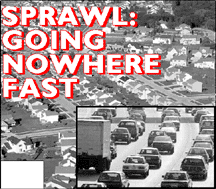|
OCT 2003
VOL 24 No. 10
FEATURES:
Subsidizing Sprawl: How Economic Development Programs Are Going Awry
by Greg LeRoy
Welcome to Wal-World: Wal-Mart’s Inexhaustible March to Conquer the Globe
by Andy Rowell
The Collapse at Cancun: A Frontline Report on the Failed WTO Negotiations
by Martin Khor
INTERVIEWS:
The Political Economy of Sprawl in the Developing World
an interview with Anna Tibaijuka
Out of Bounds: The Sprawling Metropolis and Its Discontents
an interview with Elizabeth Plater-Zyberk
DEPARTMENTS:
Behind the Lines
Editorial
The Business of Sprawl
The Front
The Politics of Chemistry - Nike’s Come-From-Behind Win
The Lawrence Summers Memorial Award
Names In the News
|
Sprawl: Going Nowhere Fast

Subsidizing Sprawl: How Economic Development Programs are Going Awry
by Greg LeRoy
Deer Creek, in northern Allegheny County, Pennsylvania, is one of the few remaining trout streams close to Pittsburgh. It runs through a rugged, wooded valley and a park before flowing into the Allegheny River. But now the creek's lower end is endangered by a proposed mall that would be subsidized by a tax increment financing (TIF) district.
"The TIF was approved long before anyone knew about the project," says Arlene Mercurio, a long-time area resident, small-business owner and parent. "There was no advertising about this project, that's for sure."
The Mercurios were shocked to learn one day in 1999 that the Allegheny County Board of Commissioners had voted to designate the 245-acre site a TIF district, which would provide taxpayer dollars to blast down one of the valley's hillsides, re-channel the creek, fill in wetlands and flatten the site to make way for a big box shopping development. MORE>>
Welcome to Wal-World: Wal-Mart’s Inexhaustible March to Conquer the Globe
by Andy Rowell
"Country by country, the world is discovering the great value of shopping at Wal-Mart," says John Menzer, president of the international division of Wal-Mart, the world's largest retailer. Menzer's vision is one where Wal-Mart becomes a global brand, just like McDonald's or Coca-Cola, monopolizing the global retail market.
People in the United States may be used to the sight of Wal-Mart in their communities, but not so the rest of the world. But all that is about to change.
Wal-Mart is already a huge player -- by far the world's largest retailer, standing 3.5 times as big as the second largest retailer, Carrefour. Now the company is employing an aggressive policy to expand its international operations and to dominate the markets where it operates. MORE>>
The Political Economy of Sprawl in the Developing World
An Interview with Anna Tibaijuka
Anna Kajumulo Tibaijuka is executive director of UN-HABITAT, the UN agency for human settlements. A Tanzanian national, Tibaijuka holds a doctorate of science in agricultural economics from the Swedish University of Agricultural Sciences in Uppsala. Prior to joining UN-HABITAT, she was the Special Coordinator for Least Developed Countries, Landlocked and Small Island Developing Countries at the United Nations Conference on Trade and Development (UNCTAD). Preceding her UNCTAD post, she served as associate professor of economics at the University of Dar-es-Salaam. She has undertaken extensive research on agriculture and human settlements policy, among other topics, and is author of five books. MORE>>
Out of Bounds: The Sprawling Metropolis and Its Discontents
An Interview with Elizabeth Plater-Zyberk
Elizabeth Plater-Zyberk is an architect and town planner who co-founded Duany Plater-Zyberk & Company in 1980. DPZ has distinguished itself by designing traditional towns and retrofitting livable downtowns into existing suburbs. Since 1995, she has been dean of the University of Miami School of Architecture. She is co-author of Suburban Nation: The Rise of Sprawl and the Decline of the American Dream. Plater-Zyberk is a co-founder and board member of the Congress for the New Urbanism (CNU), a San Francisco-based non-profit organization that works with architects, developers, planners and others involved in the creation of cities and towns, teaching them how to implement the principles of the New Urbanism. These principles include coherent regional planning, walkable neighborhoods, and attractive, accommodating civic spaces. MORE>>
|
Mailing List Search
Editor's Blog
Archived Issues
Subscribe Online
Donate Online
Links
Send Letter to the Editor
Writers' Guidelines
HOME |
